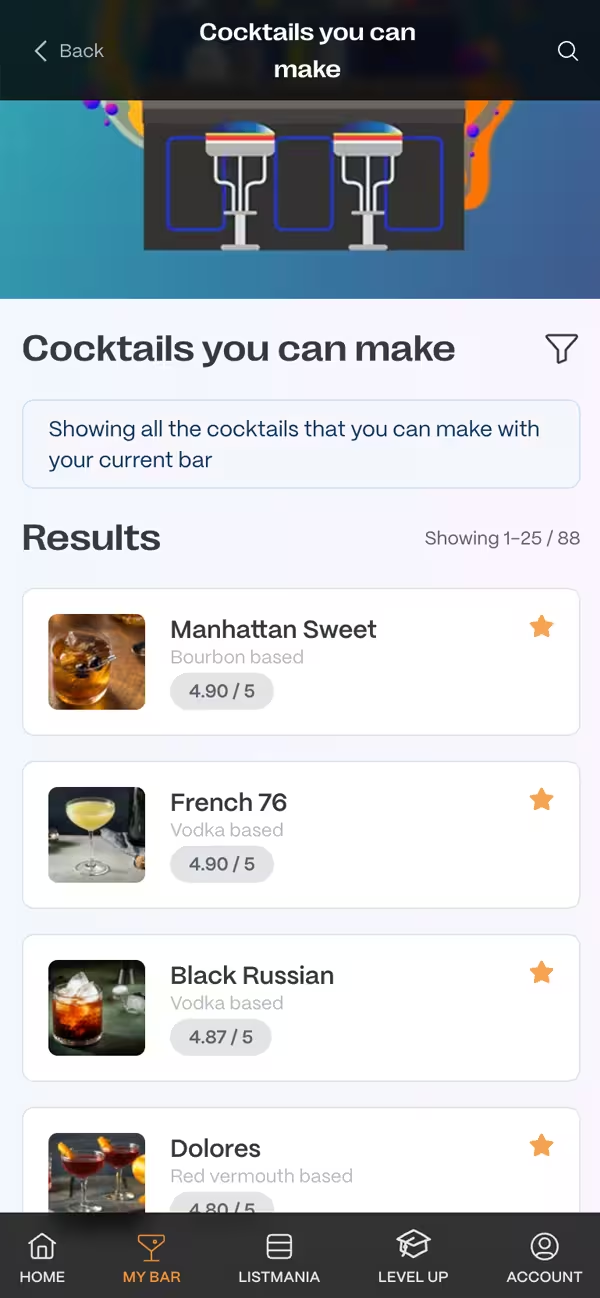World’s Strongest Cocktail: The Aunt Roberta is made entirely of alcohol—brandy, vodka, absinthe, gi...
The Art and Science of Molecular Mixology
What better way to unwind from the demands of a busy day than relaxing with a high-tech cocktail, infused with hickory smoke and chilled with liquid nitrogen. Molecular mixology utilizes scientific principles to advance the art of mixing drinks to soothe the soul and satisfy the palate. The molecular cocktail trend represents a natural extension of the molecular gastronomy movement. Molecular chefs and mixologists seek to combine seemingly incompatible ingredients that possess similar chemical compositions. Molecular bartenders also use innovative temperatures, aromas, flavors, textures and colors to create original cocktails.
Modern mixologists utilize mists, foams, gels and vapor concentrations to enlist the full molecular potential of each and every ingredient. Though the process of extracting, dehydrating and rehydrating the protein of an egg white in order to create stable foam may sound cold and calculating, it’s all about expanding the boundaries of the traditional cocktail.
The Tools of the Trade
Modern molecular mixologists employ various gadgets and instruments to devise new and creative combinations of compounds. A pipette, a large glass straw with a bulb in the middle, can be extremely valuable for layering a pousse café or a shooter. Other tools of the trade might include a Vacuum sealer, a distillation rotovap, a soda siphon or a smoker. Molecular cocktails are often supplemented with foams, solids, gels and mists.
A molecular mixologist can turn liquid into foam with the aid of carbon dioxide and a thickening agent. There are techniques for converting liquid substances into spheres and turning liquids into powders. What better way to caramelize the thick head of a cocktail than with the heat of a flaming blowtorch? Mixologists also infuse fats into spirits and grill fruits and vegetables to alter their texture and taste.
Renowned molecular mixologists like Colin Field, Head Bartender of the Paris Ritz Hotel’s Hemingway Bar, and Tony Conigliaro, Bar Manager for the Shochu Lounge in London, are revolutionizing the bartending industry. These modern alchemists use exotic ingredients like Xanthum Gum, Calcium lactate, Sodium alginate, soy lecithin and Gelatin to create tantalizing molecular cocktails for their enthralled customers. Extraordinary new cocktails like the Ramos Gin Fizz Marshmallow and the famous Pisco Sour are among the exciting new beverage concoctions. A few of the establishments well known for molecular mixology are Seattle’s Pearl, Chicago’s Red Kiva Lounge, Peche in Austin, Texas, and the St. Regis Bar in Washington, D.C.
A Simple Go To - The Screwdriver
Although some of the chemicals and tools needed in molecular mixology are out of reach for the average amateur (or even professional) mixologist, some simple, yet visually stunning, classics can be molecular-fied with the use of some simple ingredients that can be found in most large supermarket chains. The one we present here, the Screwdriver, made with orange juice and vodka, is made using the base ingredients, some sugar, and some gelatin.
In a mixing bowl add 1 teaspoon of caster suger (or fine sugar) and 2g of cold soluble gelatin. Mix with a dry spoon before adding in 250ml of vodka. Whisk up the mixture immediately, do not leave it even for a second or the gelatin can form globules with the liquid really quickly, meaning that the rest of the vodka will not set properly later on. Once mixed you should have a consistent mixture, and place this into the freezer for 15 mins.
Whilst this is solidifying, repeat the process above but for orange juice, and place this into the freezer.
Depending on how much muxture and how potent you want each serving, grab yourself between 6-10 shot glasses. Pour a thin, but distinctive layer of the vodka into each shot glass and place the glass back into the freezer for 10 mins. After the 10 mins pour a thin layer of orange juice ontop of the vodka; it should sit as a separate entity forming 2 very clear and distinctive layers.
Repeat this process, giving each layer between 5-10 mins to 'set' before pouring the next layer. Once completed you should have some amazingly, crowd pleasing striped screwdrivers, that go perfect as a special desert, or even better as a palate cleanser between courses.
The video below demontrates this process, but we find that their use of 1 glass is a little much for any sane individual!
Moving Beyond The Basics
If you've got a taste for trying out some great twists on some classic and creating some amazing crowd pleasers, then we recommend you have a look at Molecul-R, a Montreal based company who specialise in kits for the amateur and professional alike to get them started and progressing on their molecular mixology path. We expesically enjoyed trying out their Cocktail Revolution starter kits, that gives youa great base of chemicals and tools to create some weird and wonderful cocktails. Some of our highlights include:
Amaretto Sour
And the Mojito
Pardon the interruption
Did you know that you can become a member for free, taking your cocktail making skills up to level 11. You can save your My Bar ingredients, make tasting notes, have personalised Tried and Want to try lists and more.
Filed with tags
More to explore
Low-alcohol drinks have been gaining popularity in recent years, and with good reason. As more peopl...
Cocktails for Pride: Bold, Colorful, and Proud Cocktails are not just drinks; they are a celebration...
Tag cloud
Explore more with our randomised tag cloud.
-
New York
-
LAB Bar
-
Event
-
Sunny Day
-
Kir Royale
-
Design
-
Stimulating
-
Boozy
-
Vodka
-
East African
-
Boston
-
BBQ
-
Long Island Iced Tea
-
Orange Whip
-
Single Serve
-
Edible
-
Unique Taste
-
Prosecco
-
Sweet and Sour
-
Decadent Treat
Bartender's top tip
Related posts
History of the Fitzgerald
First recorded in 2002, the Fitzgerald cocktail may seem quite young to be deemed a classic. Indeed, its history is not as venerable as some other longstanding drinks in the cocktail world. However, i... read more
What Are The Different Types of Cocktail Shakers?
James Bond’s "shaken, not stirred" reference is synonymous with the history of cocktail shakers. Having been greatly influenced by the golden years of the cocktail himself, author Ian Fleming released... read more
The Ultimate Guide to Making a Perfect Gin Rickey Cocktail
The Gin Rickey is a cocktail that beautifully marries simplicity and sophistication. This guide aims to provide you with all the essential knowledge to craft the perfect Gin Rickey, making it a staple... read more
Subscribe to our Newsletter
Get tips straight into your inbox.
Upgrade your mixology
Become a member for free taking your cocktail making skills up to level 11. Or become a premium member to rise to cocktail greatness.
- Save your bar forever
- Access to our Cocktail Creator, allowing you to create your own wonderful concoctions.
- Create personalised cocktail menus for all your events, bars or parties
- Save cocktails to personalised 'Tried' and 'Want to try' lists
- Create and record tasting notes on cocktails
- Create lists of cocktails to share with friends and family
- A personalised MyBar URL, allowing you to share everything you can make with friends
- And much more ... (what to buy next, measurement choices, search personalisation...)
Have you tried our Wordpress Plugin?
Download our plugin and embed cocktail recipes directly onto your own site or blog.
Choose from our whole recipe database, or choose a specific cocktail made with a certain ingredient, and let us place a beautiful recipe on your own site.
Find out more



